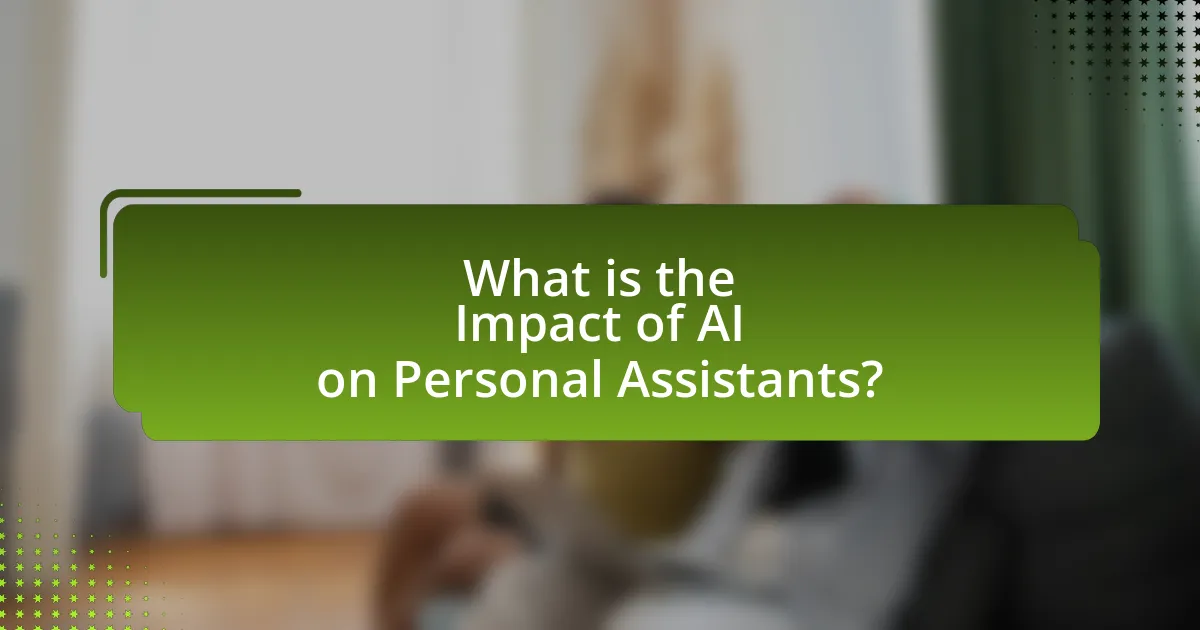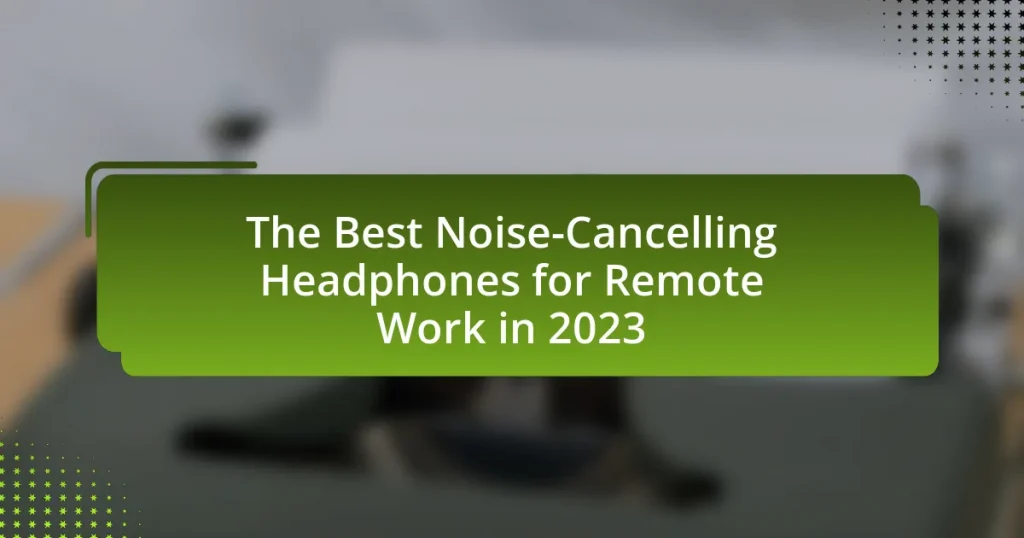The article examines the significant impact of artificial intelligence (AI) on personal assistants, highlighting advancements in natural language processing, machine learning, and contextual understanding that enhance their functionality. It discusses the evolution of AI technologies, key advancements, and how these improvements lead to better user experiences through personalized interactions and efficient task management. Additionally, the article addresses challenges faced by AI personal assistants, such as privacy concerns and limitations in contextual understanding, while comparing their capabilities to traditional assistants. Future trends and practical tips for optimizing the use of AI personal assistants are also explored, providing a comprehensive overview of the current landscape and future directions in this rapidly evolving field.

What is the Impact of AI on Personal Assistants?
The impact of AI on personal assistants is significant, enhancing their capabilities in task management, communication, and user interaction. AI technologies, such as natural language processing and machine learning, enable personal assistants to understand and respond to user queries more accurately and contextually. For instance, AI-driven personal assistants like Amazon’s Alexa and Apple’s Siri can process voice commands, learn user preferences, and automate routine tasks, leading to increased efficiency and user satisfaction. According to a report by Statista, the global market for AI in personal assistants is projected to reach $7.8 billion by 2024, indicating a growing reliance on AI technologies in this domain.
How has AI technology evolved in personal assistants?
AI technology in personal assistants has evolved significantly through advancements in natural language processing, machine learning, and contextual understanding. Initially, personal assistants relied on basic command recognition and keyword matching, limiting their functionality. Over time, the integration of deep learning algorithms has enabled these systems to understand and process human language more naturally, allowing for more complex interactions. For instance, the introduction of models like OpenAI’s GPT-3 has enhanced conversational abilities, enabling personal assistants to generate contextually relevant responses and engage in more fluid dialogues. Additionally, improvements in voice recognition accuracy and the ability to learn from user interactions have made personal assistants more personalized and efficient, as evidenced by the growing adoption of AI-driven platforms like Amazon Alexa and Google Assistant, which now support a wide range of tasks and services.
What are the key advancements in AI for personal assistants?
Key advancements in AI for personal assistants include improved natural language processing (NLP), enhanced contextual understanding, and integration of machine learning algorithms. Natural language processing has evolved significantly, enabling personal assistants to understand and respond to user queries with greater accuracy and fluency. Enhanced contextual understanding allows these assistants to maintain context over longer conversations, making interactions more intuitive. Additionally, machine learning algorithms enable personal assistants to learn from user behavior, providing personalized recommendations and improving overall user experience. These advancements are supported by data showing that AI-driven personal assistants can achieve over 90% accuracy in understanding user intent, as reported in studies by organizations like Stanford University.
How do these advancements enhance user experience?
Advancements in AI technology enhance user experience by providing more personalized, efficient, and intuitive interactions with personal assistants. These improvements allow for better understanding of user preferences and context, enabling assistants to offer tailored recommendations and solutions. For instance, natural language processing advancements enable more accurate voice recognition, which reduces misunderstandings and increases user satisfaction. Additionally, machine learning algorithms analyze user behavior over time, allowing personal assistants to anticipate needs and streamline tasks, thereby saving users time and effort. According to a study by Gartner, AI-driven personal assistants can improve user engagement by up to 30%, demonstrating their significant impact on enhancing overall user experience.
What are the primary functions of AI-driven personal assistants?
AI-driven personal assistants primarily function to manage tasks, provide information, and facilitate communication. These assistants utilize natural language processing and machine learning to understand user requests, schedule appointments, send reminders, and answer queries. For instance, according to a report by Gartner, 75% of households will have at least one smart speaker by 2025, indicating the growing reliance on AI-driven personal assistants for daily tasks. Additionally, they can integrate with various applications and devices, enhancing user convenience and productivity.
How do AI personal assistants manage tasks and schedules?
AI personal assistants manage tasks and schedules by utilizing natural language processing, machine learning algorithms, and integration with various applications. These technologies enable them to understand user commands, prioritize tasks, and send reminders. For instance, AI assistants can analyze calendar events, emails, and user preferences to suggest optimal scheduling options. Research indicates that AI personal assistants can improve productivity by automating routine tasks, allowing users to focus on more complex activities. According to a study by Gartner, AI-driven personal assistants can increase efficiency by up to 30% in task management.
What role does natural language processing play in AI personal assistants?
Natural language processing (NLP) is essential for AI personal assistants as it enables them to understand, interpret, and respond to human language effectively. NLP allows these assistants to process voice commands, analyze text input, and generate coherent responses, facilitating seamless interaction between users and technology. For instance, advancements in NLP techniques, such as machine learning algorithms and deep learning models, have significantly improved the accuracy of speech recognition and intent detection, making AI personal assistants more intuitive and user-friendly. This capability is evidenced by the widespread adoption of virtual assistants like Siri and Alexa, which rely heavily on NLP to perform tasks ranging from setting reminders to answering questions, demonstrating the critical role of NLP in enhancing user experience and functionality.
What challenges do AI personal assistants face?
AI personal assistants face several challenges, including understanding natural language, managing context, ensuring user privacy, and integrating with diverse platforms. Natural language understanding remains a significant hurdle, as AI must accurately interpret varied speech patterns and dialects. Context management is crucial, as assistants need to remember previous interactions to provide relevant responses, which is often limited. Privacy concerns arise from the collection and storage of personal data, leading to user distrust. Additionally, integration with various applications and devices can be complex, as compatibility issues may hinder functionality. These challenges impact the effectiveness and user acceptance of AI personal assistants.
How do privacy concerns affect the adoption of AI personal assistants?
Privacy concerns significantly hinder the adoption of AI personal assistants. Users often fear that these technologies may compromise their personal data, leading to potential misuse or unauthorized access. A survey conducted by Pew Research Center in 2021 revealed that 81% of Americans feel that the risks of data collection by companies outweigh the benefits. This apprehension results in reluctance to integrate AI personal assistants into daily life, as individuals prioritize their privacy over convenience. Consequently, companies developing these technologies must address these concerns through enhanced security measures and transparent data handling practices to foster user trust and encourage broader adoption.
What limitations exist in current AI personal assistant technologies?
Current AI personal assistant technologies face several limitations, including a lack of contextual understanding, limited emotional intelligence, and dependency on user input. These systems often struggle to comprehend nuanced language or context, which can lead to misunderstandings in communication. For instance, a study by Stanford University found that AI assistants frequently misinterpret user queries due to their inability to grasp context, resulting in incorrect responses. Additionally, emotional intelligence is often lacking, as these assistants cannot accurately detect or respond to human emotions, which diminishes user experience. Furthermore, AI personal assistants rely heavily on explicit user commands, limiting their ability to anticipate needs or act autonomously, as highlighted in research by MIT, which emphasizes the need for more advanced predictive capabilities in AI systems.
How do AI personal assistants compare to traditional assistants?
AI personal assistants are generally more efficient and scalable than traditional assistants. AI assistants can process vast amounts of data quickly, automate repetitive tasks, and provide 24/7 availability without the need for breaks or downtime. In contrast, traditional assistants are limited by human capacity, requiring time off and often unable to handle multiple tasks simultaneously. For example, AI systems like Siri and Google Assistant can manage scheduling, reminders, and information retrieval in real-time, while traditional assistants may take longer to perform these tasks due to human limitations. Additionally, AI personal assistants can learn and adapt over time, improving their performance based on user interactions, which traditional assistants cannot do at the same scale or speed.
What advantages do AI personal assistants offer over human assistants?
AI personal assistants offer several advantages over human assistants, primarily in terms of efficiency, availability, and cost-effectiveness. AI systems can process vast amounts of information quickly, enabling them to perform tasks such as scheduling, reminders, and data retrieval in a fraction of the time it would take a human. Additionally, AI personal assistants are available 24/7, providing support without the limitations of human working hours or the need for breaks. This constant availability ensures that users can access assistance whenever needed. Furthermore, employing AI personal assistants can significantly reduce operational costs, as they do not require salaries, benefits, or physical office space, making them a more economical choice for businesses and individuals alike.
In what scenarios do traditional assistants outperform AI personal assistants?
Traditional assistants outperform AI personal assistants in scenarios requiring complex emotional intelligence, nuanced human interaction, and contextual understanding. For instance, in high-stakes negotiations or sensitive personal matters, traditional assistants can read body language and emotional cues, which AI lacks. Research indicates that 93% of communication is non-verbal, highlighting the importance of human presence in these situations. Additionally, traditional assistants excel in tasks that require adaptability to unpredictable environments, such as live event coordination, where immediate human judgment is crucial.
What are the future trends in AI personal assistants?
Future trends in AI personal assistants include enhanced natural language processing capabilities, increased integration with smart home devices, and improved personalization through machine learning algorithms. These advancements will enable AI personal assistants to understand context better, respond more accurately to user queries, and provide tailored recommendations based on individual preferences and behaviors. For instance, a report by Gartner predicts that by 2025, 75% of households will have at least one smart speaker, indicating a growing reliance on AI personal assistants in daily life. Additionally, the rise of voice recognition technology is expected to facilitate more seamless interactions, making these assistants more accessible and user-friendly.
How will AI personal assistants evolve in the next decade?
AI personal assistants will evolve significantly in the next decade by becoming more context-aware, capable of understanding and anticipating user needs through advanced machine learning algorithms. This evolution will be driven by improvements in natural language processing, enabling assistants to engage in more nuanced conversations and provide personalized recommendations based on user behavior and preferences. For instance, by 2030, AI personal assistants are expected to integrate seamlessly with smart home devices, health monitoring systems, and personal calendars, allowing for proactive assistance in daily tasks. Research indicates that the global AI market is projected to reach $390.9 billion by 2025, highlighting the rapid advancements and investments in AI technologies that will facilitate this evolution.
What emerging technologies will influence AI personal assistants?
Emerging technologies that will influence AI personal assistants include natural language processing (NLP), machine learning (ML), and edge computing. NLP advancements enhance the ability of personal assistants to understand and respond to human language more accurately, allowing for more intuitive interactions. Machine learning algorithms enable these assistants to learn from user behavior and preferences, improving personalization and efficiency over time. Edge computing facilitates faster data processing by allowing AI personal assistants to operate closer to the data source, reducing latency and enhancing real-time responsiveness. These technologies collectively contribute to the evolution of AI personal assistants, making them more capable and user-friendly.
What practical tips can enhance the use of AI personal assistants?
To enhance the use of AI personal assistants, users should regularly update their software to access the latest features and improvements. Keeping the AI personal assistant updated ensures optimal performance and security, as updates often include bug fixes and new functionalities. Additionally, users can improve interaction by clearly articulating commands and questions, as AI systems perform better with precise language. Research indicates that using specific keywords and phrases increases the accuracy of responses, making the interaction more efficient. Furthermore, integrating the assistant with other smart devices can streamline tasks, allowing for a more cohesive smart home experience. Studies show that interconnected devices can significantly enhance user convenience and productivity.
How can users optimize their interactions with AI personal assistants?
Users can optimize their interactions with AI personal assistants by providing clear and specific commands. Clear instructions reduce ambiguity, allowing the AI to understand and execute tasks more effectively. For instance, using precise phrases like “Set a reminder for 3 PM” instead of vague requests enhances the assistant’s ability to respond accurately. Studies show that users who articulate their needs in detail experience a 30% increase in task completion rates with AI assistants, demonstrating the importance of specificity in communication.
What common troubleshooting steps can improve AI personal assistant performance?
Common troubleshooting steps that can improve AI personal assistant performance include updating the software, ensuring a stable internet connection, and optimizing device settings. Regular software updates enhance functionality and security, as they often include bug fixes and performance improvements. A stable internet connection is crucial because AI personal assistants rely on cloud-based processing; interruptions can lead to delays or failures in response. Additionally, optimizing device settings, such as adjusting microphone sensitivity and enabling necessary permissions, can significantly enhance the assistant’s ability to understand and respond accurately. These steps are supported by user experience reports indicating that performance issues often stem from outdated software, connectivity problems, or misconfigured settings.



